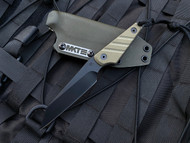The Ultimate Guide to Fixed Blade Knives: What You Need to Know
Oct 11th 2024
When it comes to knives, few tools are as versatile, durable, and dependable as fixed blade knives. Whether you’re an outdoor enthusiast, a hunter, or someone who simply appreciates a reliable tool, a fixed blade knife is a must-have in your collection. In this post, we'll dive deep into the world of fixed blade knives, exploring their benefits, uses, and key factors to consider when choosing one.
What Is a Fixed Blade Knife?
A fixed blade knife is a knife that has a blade permanently attached to the handle, meaning it doesn’t fold or retract. The blade runs from the tip all the way through the handle, providing added strength and durability. Fixed blade knives are often chosen for heavy-duty tasks because of their robust design.
Benefits of Fixed Blade Knives
- Strength and Durability
One of the most significant advantages of a fixed blade knife is its strength. With no moving parts, there’s less chance of the knife breaking, and it can withstand heavy use. Whether you’re cutting through tough material, splitting wood, or gutting a fish, a fixed blade will hold up to the task. - Versatility
Fixed blade knives are incredibly versatile. From camping and hunting to survival situations and tactical operations, they can be used for a wide range of activities. The full tang construction of most fixed blade knives adds to their ability to perform demanding tasks. - Ease of Cleaning
Unlike folding knives, fixed blade knives are easier to clean. There are no moving parts where dirt, blood, or moisture can get trapped, making maintenance a breeze. This is especially important for hunters and outdoor enthusiasts who use their knives in rugged environments. - Reliability in Emergency Situations
In survival or emergency scenarios, a fixed blade knife is invaluable. It’s ready for use the moment you need it—no need to unfold or adjust. The fixed, strong design also makes it better suited for self-defense and combat situations compared to folding knives.
Popular Uses for Fixed Blade Knives
- Hunting and Skinning: The strength and precision of fixed blades make them perfect for dressing game and skinning animals.
- Camping and Bushcraft: From cutting wood and building shelters to preparing food, a fixed blade is an essential tool for outdoor survival.
- Survival Situations: In an emergency, a fixed blade knife can help with a range of tasks including self-defense, shelter building, and fire-starting.
- Tactical and Military Use: Many military and tactical professionals rely on fixed blade knives for their reliability and strength in high-pressure situations.
- Everyday Carry (EDC): Some individuals prefer carrying a smaller fixed blade knife for everyday tasks due to its reliability and ease of use.
Types of Fixed Blade Knives
- Drop Point
One of the most popular designs for fixed blade knives, the drop point blade features a convex curve from the spine of the knife down to the tip. This design is ideal for hunters and outdoor enthusiasts, as it provides great control and precision while maintaining strength at the tip. - Tanto Blade
Known for its robust, angular tip, the tanto blade is often favored in tactical and military settings. Its strong point makes it ideal for piercing tough materials. - Clip Point
A clip point knife has a concave curve or “clip” from the spine to the tip, which allows for excellent control and precision. This type is often seen in Bowie knives and is great for detailed work. - Spear Point
With a symmetrical blade and tip aligned with the center of the blade, spear points are designed for thrusting. They are often seen in combat and tactical knives due to their stabbing capability.
Factors to Consider When Choosing a Fixed Blade Knife
- Blade Material
Blade material is crucial to the knife's performance. High-carbon steel offers excellent sharpness and durability, while stainless steel is corrosion-resistant and easier to maintain. Both materials have their pros and cons depending on your needs. - Tang Design
A full tang (where the metal of the blade extends through the handle) is generally the strongest design and is ideal for heavy-duty tasks. Partial tangs may be lighter but aren’t as durable for demanding tasks. - Handle Material
Handle material impacts both comfort and grip. Common materials include rubber, micarta, and G10, which provide excellent grip even in wet conditions. Wooden and bone handles are also available for aesthetic appeal, though they may require more maintenance. - Blade Length
The blade length will depend on what you plan to use the knife for. Longer blades (over 6 inches) are great for tasks like chopping and batoning, while shorter blades (3-5 inches) are better suited for precision tasks like carving and skinning. - Sheath Quality
The sheath is an important aspect of any fixed blade knife, as it protects both the knife and the user. Kydex and leather sheaths are popular options, offering both protection and ease of access.
Conclusion
A fixed blade knife is more than just a tool; it’s an investment in reliability and preparedness. Whether you’re venturing into the wilderness or simply need a solid everyday carry, understanding the different designs and materials will help you choose the perfect knife for your needs. When properly maintained, a fixed blade knife can last a lifetime, making it a valuable companion for any adventure.
Whether you’re a seasoned outdoorsman or new to the world of knives, a good fixed blade is an indispensable part of your kit. Ready to find the perfect fixed blade knife? Share your thoughts or experiences with fixed blade knives in the comments below!

